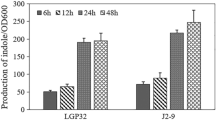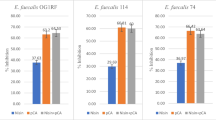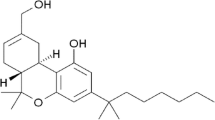Abstract
In the present study, the effects of an environmental friendly natural reagent coumarin, on the growth and potential virulence factors, as well as its ability to interfere the infection of Vibrio splendidus (Vs), were determined. Coumarin showed no effects on the maximal growth of Vs, and biofilm formation of Vs, while it significantly decreased protease activity and hemolytic activity by 43 and 80%, respectively. Correspondingly, coumarin exhibited an obviously protective effect, with a relative percent survival of 60% upon Apostichopus japonicus from infection by Vs. To preliminarily investigate the mechanism underlining the inhibitory effects, regulation of genes Vsm and Vsh respectively related to protease activity and hemolytic activity by supernatant and supernatant extract containing acyl-homoserine lactones (AHLs) and coumarin was determined. Cell-free supernatant from higher density and its ethyl acetate extract containing AHL signal molecules could respectively upregulate the mRNA level of Vsm by 17.4- and 2.3-fold and Vsh by 7.2- and 5.0-fold, when Vs was at lower cell density. However, coumarin could reduce the stimulatory effects of both the supernatant and its ethyl acetate extract. Combining all the results in our study, it was suggested that coumarin could be considered as an alternative to be used for controlling infection of Vs, downregulating the expression of potential virulence factors through interfering the AHL-mediated pathways.








Similar content being viewed by others
References
Amend DF (1981) Potency testing of fish vaccine. Dev Biol Stand 49:447–454
Bruhn JB, Dalsgaard I, Nielsen KF, Buchholtz C, Larsen JL, Gram L (2005) Quorum sensing signal molecules (acylated homoserine lactones) in gram-negative fish pathogenic bacteria. Dis Aquat Org 65:43–52
Chu WH, Zhou SX, Zhu W, Zhuang XY (2014) Quorum quenching bacteria Bacillus sp. QSI-1 protect zebrafish (Danio rerio) from Aeromonas hydrophila infection. Sci Rep 4:5446
de Souza SM, Delle MF, Jr SA (2005) Antibacterial activity of coumarins. Z Naturforsch C 60:693–700
Decker SD, Reynaud Y, Saulnier D (2013) First molecular evidence of cross-species induction of protease gene expression in vibrio strains pathogenic for pacific oyster Crassostrea gigas involving a quorum sensing system. Aquaculture 392–395:1–7
Deng H, Zhou ZC, Wang NB, Liu C (2008) The syndrome of sea cucumber (Apostichopus japonicas) infected by virus and bacteria. Virol Sin 23:63–67
Felter SP, Vassallo JD, Carlton BD, Daston GP (2006) A safety assessment of coumarin taking into account species-specificity of toxicokinetics. Food Chem Toxicol 44:462–475
Gutiérrez-Barranquero JA, Reen FJ, McCarthy RR, O’Gara F (2015) Deciphering the role of coumarin as a novel quorum sensing inhibitor suppressing virulence phenotypes in bacterial pathogens. Appl Microbiol Biotechnol 99(7):3303–3316
Han Y, Li X, Qi ZZ, Zhang XH, Bossier P (2010) Detection of different quorum-sensing signal molecules in a virulent Edwardsiella tarda strain LTB-4. J Appl Microbiol 108(1):139–147
Henke JM, Bassler BL (2004) Quorum sensing regulates type III secretion in Vibrio harveyi and Vibrio parahaemolyticus. J Bacteriol 186:3794–3805
Lee JH, Kim YG, Cho HS, Ryu SY, Cho MH, Lee J (2014) Coumarins reduce biofilm formation and the virulence of Escherichia. Phytomedicine 21:1037–1042
Li H, Qiao G, Gu JQ, Zhou W, Li Q, Woo SH, Xu DH, Park SI (2010) Phenotypic and genetic characterization of bacteria isolated from diseased cultured sea cucumber Apostichopus japonicus in northeastern China. Dis Aquat Org 91:223–235
Li XY, Jing KL, Wang XT, Li Y, Zhang MX, Li Z, Xu L, Wang LL, Xu YP (2015) Protective effects of chicken egg yolk antibody (IgY) against experimental Vibrio splendidus infection in the sea cucumber (Apostichopus japonicas). Fish Shellfish Immun 48:105–111
Liang WK, Zhang C, Liu NN, Zhang WW, Han QX, Li CH (2016) Cloning and characterization of Vshppd, a gene inducing haemolysis and immune response of Apostichopus japonicus. Aquaculture 464:246–252
Lilley BN, Bassler BL (2000) Regulation of quorum sensing in Vibrio harveyi by LuxO and sigma-54. Mol Microbiol 36:940–954
Liu H, Zheng F, Sun X (2010a) Identification of the pathogens associated with skin ulceration and peristome tumescence in cultured sea cucumbers Apostichopus japonicus (Selenka). J Invertebr Pathol 105:236–242
Liu HB, Lee JH, Kim JS, Park S (2010b) Inhibitors of the Pseudomonas aeruginosa quorum-sensing regulator, QscR. Biotechnol Bioeng 106:119–126
Manefield M, Harris L, Rice SA, de Nys R, Kjelleberg S (2000) Inhibition of luminescence and virulence in the black tiger prawn (Penaeus monodon) pathogen Vibrio harveyi by intercellular signal antagonists. Appl Environ Microbiol 66:2079–2084
Mcclean KH, Winson MK, Fish L, Taylor A, Chhabra SR, Camara M (1997) Quorum sensing and Chromobacterium violaceum: exploitation of violacein production and inhibition for the detection of n-acylhomoserine lactones. Microbiol 143:3703–3711
Mok KC, Wingreen NS, Bassler BL (2003) Vibrio harveyi quorum sensing : a coincidence detector for two autoinducers controls gene expression. EMBOJ 22:870–881
Musthafa KS, Sivamaruthi BS, Pandian SK (2012) Quorum sensing inhibition in Pseudomonas aeruginosa PAO1 by antagonistic compound phenylacetic acid. Curr Microbiol 65:475–480
Natrah FM, Ruwandeepika HA, Pawar S, Karunasagar I, Sorgeloos P, Bossier P (2011a) Regulation of virulence factors by quorum sensing in Vibrio harveyi. Vet Microbiol 154:124–129
Natrah FMI, Defoirdt T, Sorgeloos P, Bossier P (2011b) Disruption of bacterial cell-to-cell communication by marine organisms and its relevance to aquaculture. Mar Biotechnol 13:109–126
Ojala T, Remes S, Haansuu P, Vuorela H, Hiltunen R, Haahtela K, Vuorela P (2000) Antimicrobial activity of some coumarin containing herbal plants growing in Finland. J Ethnopharmacol 73:299–305
Purohit AA, Johansen JA, Hansen H (2013) Presence of acyl-homoserine lactones in 57 members of the Vibrionaceae, family. J Appl Microbiol 115:835–847
Sambrook J, Maniatis T, Fritsch EF (1989) Molecular cloning: a laboratory manual, 2nd edn. Cold Spring Harbor Laboratory Press, Cold Spring Harbor, NY
Steenackers HP, Levin J, Janssens JC, DeWeerdt A, Balzarini J, Vanderleyden J (2010) Structure-activity relationship of brominated 3-alkyl-5-methylene-2(5H)- furanones and alkylmaleic anhydrides as inhibitors of Salmonella biofilm formation and quorum sensing regulated bioluminescence in Vibrio harveyi. Bioorg Med Chem 18:5224–5233
Truchado P, Larrosa M, Castro-Ibáñez I, Allende A (2015) Plant food extracts and phytochemicals: their role as quorum sensing inhibitors. Trends Food Sci Tech 43:189–204
Viswanath G, Jegan S, Baskaran V, Kathiravan R, Prabavathy VR (2015) Diversity and N-acyl-homoserine lactone production by gammaproteobacteria associated with Avicennia marina rhizosphere of south Indian mangroves. Syst Appl Microbiol 38:340–345
Zang T, Lee BW, Cannon LM, Ritter KA, Dai S, Ren D (2009) A naturally occurring brominated furanone covalently modifies and inactivates LuxS. Bioorg Med Chem Lett 19:6200–6204
Zhang CY, Wang YG, Rong XJ (2006) Isolation and identification of causative pathogen for skin ulcerative syndrome in Apostichopus japonicas. J Fish Sci China 30:118–123
Zhang Q, Ma HM, Mai KS, Zhang WB, Liufu Z, Xu W (2010) Interaction of dietary Bacillus subtilis and fructooligosaccharide on the growth performance, non-specific immunity of sea cucumber, Apostichopus japonicas. Fish Shellfish Immun 29:204–211
Zhang WW, Hu YH, Wang HL, Sun L (2009) Identification and characterization of a virulence-associated protease from a pathogenic Pseudomonas fluorescens strain. Vet Microbiol 139:183–188
Zhang WW, Li CH (2016) Exploiting quorum sensing interfering strategies in gram-negative bacteria for the enhancement of environmental applications. Front Microbiol 6:1535
Zhang WW, Liang WK, Li CH (2016) Inhibition of marine vibrio sp. by pyoverdine from pseudomonas aeruginosa PA1. J Hazard Mater 302:217–224
Zhang WW,Yin K, Li BW, Chen LX (2013) A glutathione S-transferase from Proteus mirabilis involved in heavy metal resistance and its potential application in removal of Hg2+. J Hazard Mater 261:646–652
Author information
Authors and Affiliations
Corresponding authors
Ethics declarations
Funding
This study was funded by the National Natural Science Foundation of China (41676141 and 41276120), the Zhejiang Open Foundation of The Most Important Subjects (XKZSC1407 and XKZSC1408), the Natural Science foundation of Ningbo (2015C50057), the public welfare Technology Application Research Project of Zhejiang (2016C33022), and the K.C. Wong Magna Fund at Ningbo University.
Conflict of interest
The authors declare that they have no conflict of interest.
Ethical approval
All applicable international, national, and/or institutional guidelines for the care and use of animals were followed.
Rights and permissions
About this article
Cite this article
Zhang, S., Liu, N., Liang, W. et al. Quorum sensing-disrupting coumarin suppressing virulence phenotypes in Vibrio splendidus . Appl Microbiol Biotechnol 101, 3371–3378 (2017). https://doi.org/10.1007/s00253-016-8009-3
Received:
Revised:
Accepted:
Published:
Issue Date:
DOI: https://doi.org/10.1007/s00253-016-8009-3




